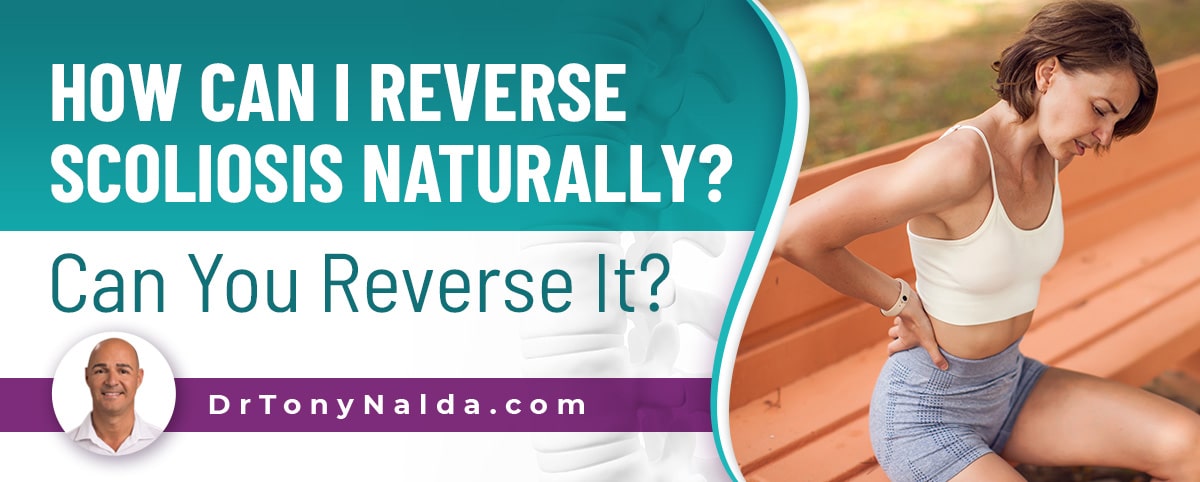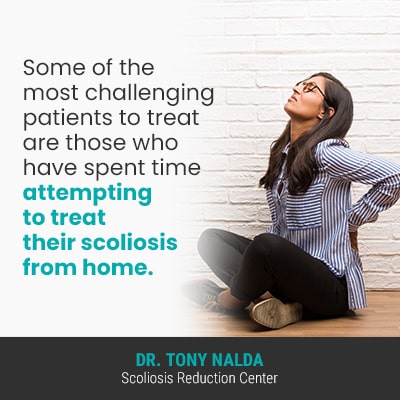How Can I Reverse Scoliosis Naturally? Can You Reverse It?

For those wanting to know if scoliosis can be reversed naturally, I find there are two parts to this question: can scoliosis be effectively treated through a DIY at-home approach, and can it be treated without the use of invasive medications and surgical procedures? Continue reading for answers to both questions.
Scoliosis is a progressive condition, meaning it has it in its very nature to worsen over time. Permanently reversing scoliosis isn't possible because although it's highly treatable, it's not curable. A conservative treatment approach is more natural than invasive traditional treatment.
Although incurable, scoliosis is highly treatable, but before getting to the specifics of treatment, lets first discuss what it means to be diagnosed with scoliosis.
Table of Contents
What Does it Mean to be Diagnosed with Scoliosis?
Being diagnosed with scoliosis can be a lot to process; what a diagnosis means is that an unnatural sideways spinal curve has developed, with rotation, and a minimum Cobb angle measurement of 10 degrees.
Scoliosis is progressive, meaning it has it in its nature to worsen over time, particularly if left untreated, or not treated proactively.
So where a scoliosis is at the time of diagnosis is not indicative of where it will stay, which is why proactive treatment is so important.
Scoliosis ranges widely in severity from mild to moderate and severe to very severe, and even scoliosis diagnosed as mild can easily progress to become moderate, severe, or very severe; only proactive treatment can counteract the condition's progressive nature.
Having scoliosis means a lot of uneven forces are being introduced to the body, and in most cases, the body's overall symmetry is disrupted.
The main symptom of scoliosis in adolescents is postural deviation such as uneven shoulders and hips, and the main symptom in adults is pain, both localized back and radicular pain felt throughout the body.
So for those recently diagnosed, the most important decision to be made is how to treat it moving forward, and some patients feel they might be able to treat it naturally at home with a DIY approach.
Can I Treat My Scoliosis Naturally at Home?
While I applaud the efforts of patients being proactive with their health and seeking out alternative forms of treatment, there are definitely risks associated with self-assessment and self-treatment.
With complex conditions like scoliosis, even more-natural approaches need to be crafted and applied by an experienced scoliosis specialist trained in the specifics of the condition and how it responds to treatment.
 Some of the most challenging patients to treat are those who have spent time attempting to treat their scoliosis from home.
Some of the most challenging patients to treat are those who have spent time attempting to treat their scoliosis from home.
Patients do their own research and/or consult with a doctor or physical therapist, and based on these findings, they design their own scoliosis-friendly treatment plan including diet, exercise, and stretches.
Some of these patients might have had some good ideas, and their motivation was strong, but with complex progressive conditions like scoliosis, an integrative approach to treatment is needed, which is more than an average individual can provide from home.
Most patients attempting home-treatment come to see me when they realize their efforts aren't working and that their condition has gotten worse, which it has in its nature to do, and those efforts failed at slowing, or preventing, further progression.
This can be discouraging news for patients who've been trying to make improvements to no avail, and there is a strong correlation between early detection and treatment success, but the benefits of early detection are only available to those who have responded proactively with the right type of treatment.
That being said, however, it is never too late to start treatment, and while these types of patients are often starting treatment later than I would like, there is always potential to achieve a curve reduction when a multifaceted approach has been applied.
Regardless of how committed a patient is to their home-care regimen and scoliosis-friendly lifestyle, assessment via X-ray is an important part of treatment, and unless patients have access to x rays at home, they can't possibly assess how their spine is responding to treatment.
The above scenario is cautionary; I want patients to understand that even when working with us here at the Scoliosis Reduction Center, there is an important at-home component to every treatment plan, but the at-home portion is only one facet of treatment plans I customize for each and every patient.
So now that we've addressed some of the dangers associated with self-assessment and at-home treatment, let's talk about the difference between the two main scoliosis treatment approaches available: traditional methods vs conservative treatment.
Traditional Surgical Treatment
The traditional treatment approach tends to include medication for pain management, and invasive spinal fusion surgery.
While scoliosis surgery can be successful at straightening a crooked spine, the way it does so, by fusing multiple spinal vertebrae together into one solid bone, removing spinal discs, and attached rods to the spine with screws to hold it in place is contrary to the spine's natural movement-based design.
So even when successful, invasive procedures that involve surgery are known to disrupt the spine's natural strength, function, and range of motion.
Traditional treatment doesn't have a strategy for treating scoliosis while mild, when it's going to be the most responsive to treatment, so advises patients with mild scoliosis to watch and wait to see if the condition progresses, but as a progressive condition, most scoliosis cases are going to progress at some point.
So waiting for signs of a progressive condition progressing, before starting treatment, is wasting valuable treatment time, to me.
Traditional treatment focuses on stopping progression, but isn't working towards a curvature reduction that preserves the spine's natural function and strength, as does a more-natural treatment approach.
Conservative Treatment Approach
When it comes to conservative treatment, we're talking about a nonsurgical approach to treating scoliosis that focuses on preserving as much of the spine's natural strength and function as possible.
 Conservative treatment values a proactive response to a scoliosis diagnosis, regardless of severity.
Conservative treatment values a proactive response to a scoliosis diagnosis, regardless of severity.
When I diagnose a patient with mild scoliosis, I want to start treatment right away, even though it's mild at the time, because this is when there are fewer limits to what I can achieve.
Scoliosis is simpler to treat while mild, while the curve is smaller, more flexible (spinal rigidity increases with progression), more responsive to treatment, and before the body has had time to adjust to the unnatural curve's presence.
By being proactive, I can try and stay ahead of a patient's progressive line; that way progression, increasing condition severity, escalating symptoms, and the need for more invasive spinal surgery in the future can be avoided.
As a structural condition, it has to be impacted structurally, first and foremost, and I work towards this with condition-specific chiropractic adjustments which, when successful, can fix scoliosis naturally.
Through chiropractic care and manual adjustments, I can reposition the most-tilted vertebrae back into alignment with the rest of the spine.
Once I start to see those types of structural results, I can shift the focus to holding the spine in that corrective position by using physical therapy and scoliosis exercises to increase core strength so the spine's surrounding muscles can support it.
With corrective bracing, I can augment corrective results further as the brace pushes the spine into a corrective position.
Through a series of custom-prescribed exercises, I can help patients establish a home-rehabilitation program to further stabilize the spine for long-term sustainable results.
So through chiropractic care, you can see that strengthening the spine's surrounding muscles through scoliosis exercises is a more natural approach to holding the spine in position, than having to undergo surgery that involves the spine being held in place through artificial means.
While a full reversal might not be possible every time, a significant curvature reduction reduces the uneven forces exposed to the body, improving spinal health, function, and biomechanics, in most scoliosis patients.
Conclusion
When it comes to reversing scoliosis, we're talking about how to reduce the size (cobb angle) of the scoliotic curvature of the spine.
While it can be tempting to take a DIY approach and attempt home treatment, I caution patients against this as scoliosis is a complex condition that necessitates the customization of effective treatment plans; it needs to be impacted on every level through the combination of multiple treatment disciplines.
For those on the at-home treatment path, unless they have access to an X-ray machine, there is no way to actually identify what's happening in and around the spine, and how it's responding to treatment.
Without being able to assess their scoliosis comprehensively, as it needs to be, conditions can be continuously progressing, and it's not until that progression is noticeable, that these patients come to see me with concerns about their condition.
While a traditional treatment approach has been around for many years, it funnels patients towards spinal surgery, which is a costly, lengthy, and invasive procedure that can cost the spine in terms of its overall strength and function.
There is, however, a more natural scoliosis treatment approach, known as conservative, that focuses on reducing the curve on a structural level and increasing core strength for spinal support, rather than holding the spine in place with rods and screws that can malfunction.
Here at the Scoliosis Reduction Center, patients benefit from accessing multiple scoliosis-specific treatment disciplines at one location and a more natural treatment approach.
Dr. Tony Nalda
DOCTOR OF CHIROPRACTIC
After receiving an undergraduate degree in psychology and his Doctorate of Chiropractic from Life University, Dr. Nalda settled in Celebration, Florida and proceeded to build one of Central Florida’s most successful chiropractic clinics.
His experience with patients suffering from scoliosis, and the confusion and frustration they faced, led him to seek a specialty in scoliosis care. In 2006 he completed his Intensive Care Certification from CLEAR Institute, a leading scoliosis educational and certification center.
About Dr. Tony Nalda
 Ready to explore scoliosis treatment? Contact Us Now
Ready to explore scoliosis treatment? Contact Us Now





